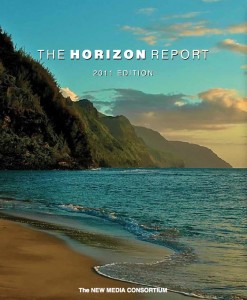 According to 2011 Horizon Report Augmented Reality will go mainstream as a learning technology within two years.
According to 2011 Horizon Report Augmented Reality will go mainstream as a learning technology within two years.
The Horizon Reports describe the continuing work of the New Media Consortium’s Horizon Project, a comprehensive research venture established in 2002 that identifies and describes emerging technologies likely to have a large impact over the coming five years on a variety of sectors around the globe. The 2011 Horizon Report, examines emerging technologies for their potential impact on and use in teaching, learning,and creative inquiry. Each edition of the Horizon Report introduces six emerging technologies or practices that are likely to enter mainstream use within three adoption horizons over the next five years.
The technologies are placed along three adoption horizons that indicate likely time frames for their entrance into mainstream use for teaching, learning, or creative inquiry. The near-term horizon assumes the likelihood of entry into the mainstream for institutions within thenext twelve months; the mid-term horizon, within two to three years; and the far-term, within four to five years.
Augmented reality is an active, not a passive technology; students can use it to construct new understanding based on interactions with virtual objects that bring underlying data to life. Dynamic processes, extensive datasets, and objects too large or too small to be manipulated can be brought into a student’s personal space at a scale and in a form easy to understand and work with. In a broader context of education, augmented reality is appealing because it aligns with situated learning. Students find connections between their lives and their education through the addition of a contextual layer.
This post is also available in: Italian
